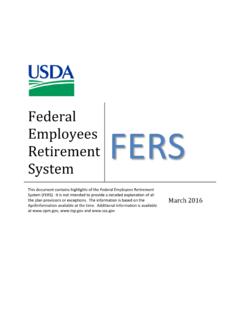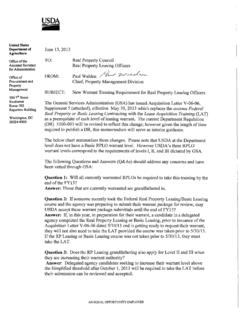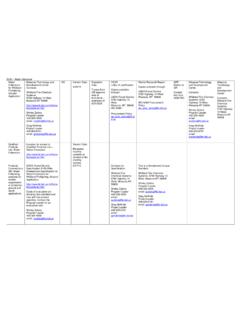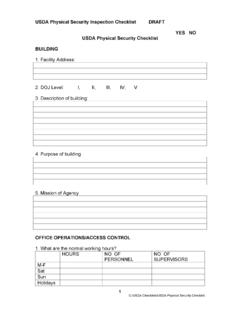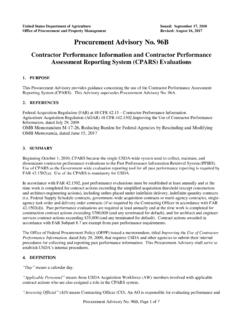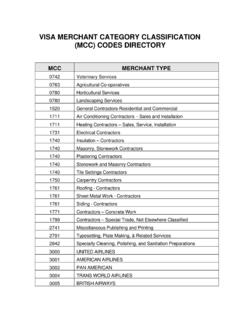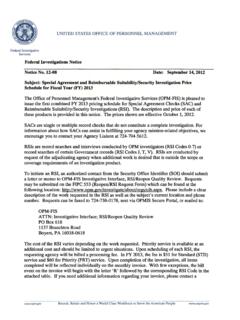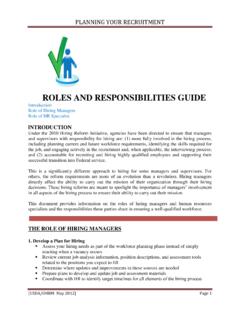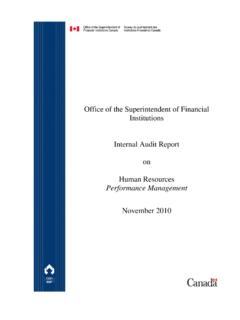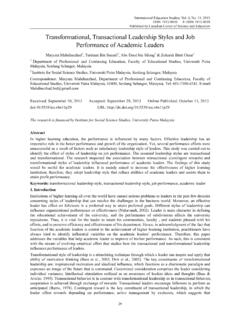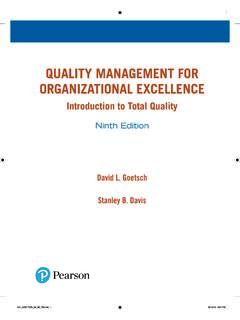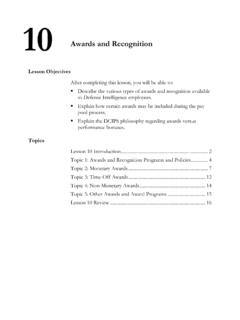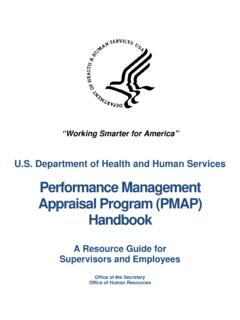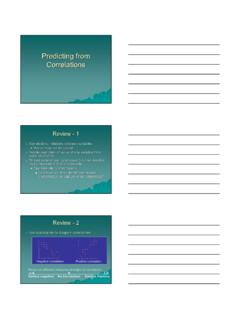Transcription of Leadership Competency Self Assessment
1 UUSSDDAA VViirrttuuaall UUnniivveerrssiittyy SScchhooooll ooff TTaalleenntt MMaannaaggeemmeenntt LLeeaaddeerrsshhiipp EEsssseennttiiaallss CCeerrttiiffiiccaattee PPrrooggrraamm Updated: March 2013 Leadership Competency Self Assessment BBuuiillddiinngg BBlloocckkss ffoorr WWoorrkkffoorrccee DDeevveellooppmmeenntt Based on OPM Competencies What is a Competency ? A Competency is the integration of one s knowledge, skills, abilities and attributes in order to perform effectively on the job. Competencies are observable and measurable behaviors, which are critical to successful individual and agency performance .
2 Competencies applied through behaviors help to ensure organizational/mission critical results and outcomes. The 10 foundational Leadership competencies for all employees form the foundation upon which Leadership success is built. Knowledge, skill and ability in each of these ten competencies are the basis on which to build success as a leader. Each of the five organizational Leadership levels builds upon the foundation. Even though an upward progression of employee levels is shown, the progression of Leadership development is not always linear. Leadership competencies displayed for each organizational Leadership level in this chart are situational, and are not cast in stone.
3 As times change, our mission will require that the organization make changes too. The competencies leaders need now may not be the same competencies that leaders will need in the future. The Competency Chart may need to be updated as organizational changes evolve in the future. This self- Assessment is designed to educate leaders at the All Employees and Team Leader levels regarding the competencies required for their success. For the leader who has reached their target level, a Competency self Assessment can be useful to help identify strengths and areas for improvement for the purpose of continuous learning. Also, supervisors can use the self Assessment as a tool for coaching and mentoring their aspiring subordinates.
4 Leadership Competency Self Assessment Directions DIRECTIONS: Use the definitions and proficiency levels for a self Assessment . 1. Determine your current employee level, using the Competency Chart and Leadership Journey on the next page. 2. Review your current job description to identify Leadership competencies required. 3. Using the fill able Assessment for your employee level, check the box next to your perceived proficiency. 4. If you are interested in a higher employee level you may assess your Competency proficiency for that level as well. 5. Choose 2-3 of the competencies you wish to develop. 6. Share the self Assessment with your supervisor if you wish or have them rate your proficiency on a blank set.
5 7. Research the types of learning experiences, courses, or programs that you would like to participate in. Use the Employee and Leadership Development catalog as a resource. Be sure to check for online (Aglearn) Skillsoft courses that specifically address competencies. 8. Document on your IDP. Please note that the Assessment does not provide a basis for acceptable level competencies. Your perceived level may be different than your supervisor. Use this as an opportunity to discuss your development and Leadership skill gaps. This Assessment and all competencies are based on OPM Competency definitions and proficiency levels. Competency Chart and Leadership Journey USDA Competency Chart and Employee Level Employee Level Responsibility/Role Competencies Manager Managing Programs Individuals in management positions who typically supervise one or more supervisors Creativity and Innovation Partnering Political Savvy Technology Management Supervisor Managing People First line supervisors who do not supervise other supervisors.
6 Typically are responsible for employees performance appraisals Developing Others Financial Management Human Resources Management Leveraging Diversity SUPERVISOR Developing Others - Develops the ability of others to perform and contribute to the organization by providing ongoing feedback and by providing opportunities to learn through formal and informal methods. Proficiency Level Proficiency Level Definition Proficiency Level Illustrations Check Level 5 Expert Level 4 Advanced Applies the Competency in exceptionally difficult situations Serves as a key resource and advises others Applies the Competency in considerably difficult situations Designs and implements opportunities for career development in anticipation of agency restructuring, including mentoring staff and providing training Directs working group to design training programs focused on skills necessary for meeting strategic goals Designs, implements.
7 And communicates Leadership development opportunities for staff at all levels in the organization Recommends details and developmental assignments to staff based on career interests and work unit needs Generally requires little or no guidance Recognizes staff potential and guides employees in developing skills by recommending appropriate training and sources of information Works with staff to develop individual development plans addressing employee needs and meeting organizational goals Level 3 Intermediate Applies the Competency in difficult situations Requires frequent guidance Assesses staff and provides timely and consistent feedback regarding technical proficiency and effectiveness Provides constructive feedback, guidance.
8 And reinforcement to employees regarding job performance Works with staff to identify work goals and create individual development plans Evaluates training programs to ensure content meets staff needs Level 2 Basic Level 1 Awareness Applies the Competency in somewhat difficult situations Requires frequent guidance Applies the Competency in the simplest situations Encourages employees to participate in mentoring programs and other learning opportunities Pairs new staff with seasoned employees to facilitate understanding of the position and organization Provides orientation to new employees Provides developmental feedback to staff on job performance Requires close and extensive guidance Involves staff in developing project goals and timelines SUPERVISOR Financial Management - Understands the organization's financial processes.
9 Prepares, justifies, and administers the program budget. Oversees procurement and contracting to achieve desired results. Monitors expenditures and uses cost-benefit thinking to set priorities. Proficiency Level Proficiency Level Definition Proficiency Level Illustrations Check Level 5 Expert Level 4 Advanced Applies the Competency in exceptionally difficult situations Serves as a key resource and advises others Applies the Competency in considerably difficult situations Designs and implements an agency-wide financial management system to meet organizational objectives Develops agency-wide financial procurement procedures and policies Audits major acquisitions having agency-wide impact, presents findings.
10 And recommends corrective actions Develops and implements new procurement system to support agency program within time and budgetary constraints Generally requires little or no guidance Ensures financial commitments and deadlines are met by facilitating and assessing processes, situations, and issues and takes corrective action, as needed Considers implications of financial decisions and suggests methods for meeting needs of staff and the organization overall Level 3 Intermediate Applies the Competency in difficult situations Requires frequent guidance Conducts research to determine resource needs and guides the procurement process to acquire resources Conducts a cost-benefit analysis to develop sound financial plans with programmatic impact Follows established guidelines and procedures to ensure approval of funding for key initiatives Prepares and monitors office's annual operating budget Level 2 Basic Applies the Competency in somewhat difficult situations Requires
